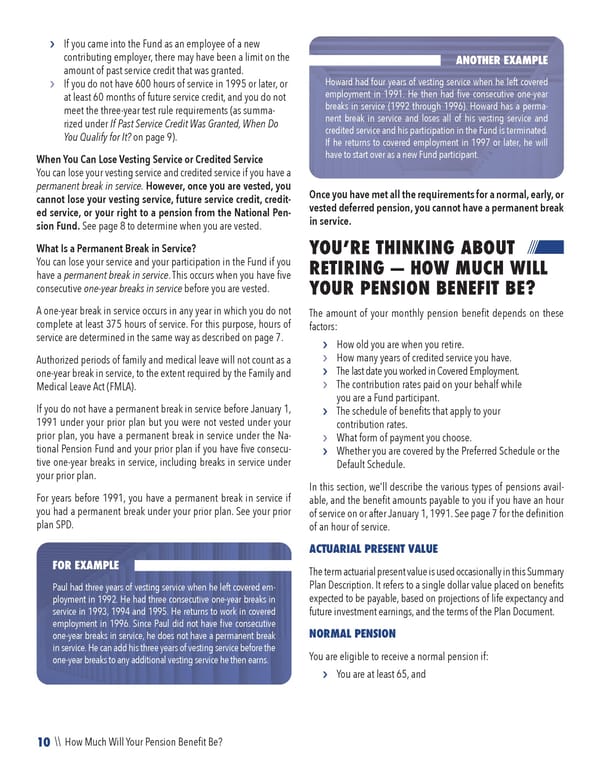10 \\ How Much Will Your Pension Benefit Be? › If you came into the Fund as an employee of a new contributing employer, there may have been a limit on the amount of past service credit that was granted. › If you do not have 600 hours of service in 1995 or later, or at least 60 months of future service credit, and you do not meet the three-year test rule requirements (as summa- rized under If Past Service Credit Was Granted, When Do You Qualify for It? on page 9). When You Can Lose Vesting Service or Credited Service You can lose your vesting service and credited service if you have a permanent break in service. However, once you are vested, you cannot lose your vesting service, future service credit, credit- ed service, or your right to a pension from the National Pen- sion Fund. See page 8 to determine when you are vested. What Is a Permanent Break in Service? You can lose your service and your participation in the Fund if you have a permanent break in service. This occurs when you have five consecutive one-year breaks in service before you are vested. A one-year break in service occurs in any year in which you do not complete at least 375 hours of service. For this purpose, hours of service are determined in the same way as described on page 7. Authorized periods of family and medical leave will not count as a one-year break in service, to the extent required by the Family and Medical Leave Act (FMLA). If you do not have a permanent break in service before January 1, 1991 under your prior plan but you were not vested under your prior plan, you have a permanent break in service under the Na- tional Pension Fund and your prior plan if you have five consecu- tive one-year breaks in service, including breaks in service under your prior plan. For years before 1991, you have a permanent break in service if you had a permanent break under your prior plan. See your prior plan SPD. Once you have met all the requirements for a normal, early, or vested deferred pension, you cannot have a permanent break in service. YOU’RE THINKING ABOUT RETIRING — HOW MUCH WILL YOUR PENSION BENEFIT BE? The amount of your monthly pension benefit depends on these factors: › How old you are when you retire. › How many years of credited service you have. › The last date you worked in Covered Employment. › The contribution rates paid on your behalf while you are a Fund participant. › The schedule of benefits that apply to your contribution rates. › What form of payment you choose. › Whether you are covered by the Preferred Schedule or the Default Schedule. In this section, we’ll describe the various types of pensions avail- able, and the benefit amounts payable to you if you have an hour of service on or after January 1, 1991. See page 7 for the definition of an hour of service. ACTUARIAL PRESENT VALUE The term actuarial present value is used occasionally in this Summary Plan Description. It refers to a single dollar value placed on benefits expected to be payable, based on projections of life expectancy and future investment earnings, and the terms of the Plan Document. NORMAL PENSION You are eligible to receive a normal pension if: › You are at least 65, and FOR EXAMPLE Paul had three years of vesting service when he left covered em- ployment in 1992. He had three consecutive one-year breaks in service in 1993, 1994 and 1995. He returns to work in covered employment in 1996. Since Paul did not have five consecutive one-year breaks in service, he does not have a permanent break in service. He can add his three years of vesting service before the one-year breaks to any additional vesting service he then earns. ANOTHER EXAMPLE Howard had four years of vesting service when he left covered employment in 1991. He then had five consecutive one-year breaks in service (1992 through 1996). Howard has a perma- nent break in service and loses all of his vesting service and credited service and his participation in the Fund is terminated. If he returns to covered employment in 1997 or later, he will have to start over as a new Fund participant.
 2023 NPF Summary Plan Description Page 11 Page 13
2023 NPF Summary Plan Description Page 11 Page 13